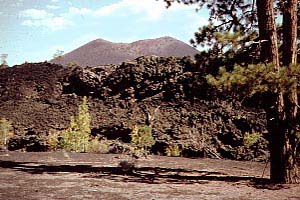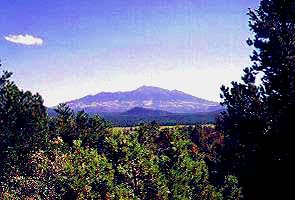 |
Sunset
Crater Study Site
Soil
Type: Cinders - Lava Flow
Location: 50 km Northeast of Flagstaff, AZ off
US 89
Elevation: 4800' - 6000' (1400 - 1800m)
Description: Area of old volcanic activity with
lava fields and cinder soils. Sunset Crater is an
extinct cinder cone. |
 |
Red
Mountain Study Site
Soil
Type: Sandy-Loam
Location: 80 km North of Flagstaff, AZ on US 180
Elevation: 6400' - 7000' (1900 - 2100 m)
Description: The Red Mountain study area is located
north of the San Francisco Peaks and is characterized
by a Pinyon-Juniper woodland area with assorted grasses
and shrubery. |
 |
Winona
Study Site
Soil
Type: Sandy-Loam
Location: 30 km East of Flagstaff, AZ off I 40
Elevation: 6000' - 7000' (1800 - 2100 m)
Description: The Winona study area is located
at the southern most edge of the Colorado Plateau. It
is a Pinyon-Juniper woodlands area that runs along Walnut
Canyon. There are also large amounts of grasslands
in the area. |
Summary
Graphs from Sunset Crater, Red Mountain & Winona Study Sites
In 1995, we began monitoring insect herbivores and tree performance
of intermediate sized trees (~70 years of age) on two different
soil types. Cinder soils are known to be drier and more nutrient
poor than sandy-loam soils. Each site consists of 30 trees: six
sites are located on cinder soils near Sunset Crater National
Monument, and six sites are located on sandy-loam soils - three
each near Winona and Red Mountain north of the San Francisco Peaks.
In 1997, 30 small trees (~40 years of age) were added to each
site and monitored in the same way. Some of our results are presented
below:
Cone Production:
In one year (1999) a sandy-loam site, Red Mountain, had higher
cone production than the other sites, and in another year (2001)
the Sunset Crater cinder site had the highest cone production
(Fig. 1).
Seed Viability:
Of the seeds produced during the mast year 1999, 60% were viable
on sandy-loam, compared to 30% on cinders (Fig.
2).
Conelet Production:
Conelet production has similar year to year and site to site variation
as cone production, with the peaks a year ahead of when they occur
for cones (Fig.
3).
Male Strobili Production:
Strobili production is, overall, higher on cinder soils at Sunset
Crater than on sandy-loam soils (Fig.
4).
Aboveground Production:
Mean annual stem growth was higher on sandy-loam soils than on
cinders for most years before the onset of drought in 1996, both
in intermediate trees (Fig.
5), and in small trees (Fig.
5a). After 1996, stem growth is fairly similar among sites.
Needle litterfall, a proxy for needle production, is generally
higher on sandy-loam soils (Fig.
6).
Moth Herbivory:
Herbivory by the stem-boring moth Dioryctria albovittella
is generally higher on cinder soils than on sandy-loam in intermediate
trees (Fig. 7).
Tree Rings:
We have data on annual tree ring width for the 70-year-old trees
until 1997. Fig.
8 shows growth response to scale insect herbivory, while Fig.
9 shows trees ring growth across the two soil types. Since
1940, trees on sand-loam soils have shown significantly more growth
than trees on cinders in 24 years, while trees on cinders have
shown higher growth in 11 years.
|



